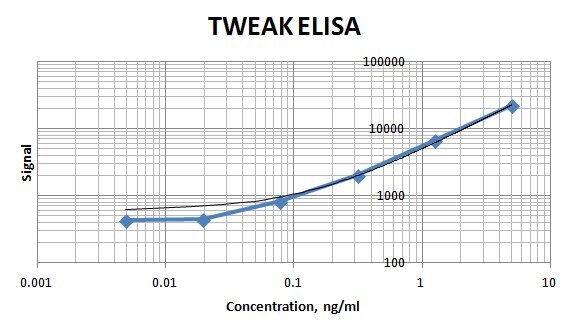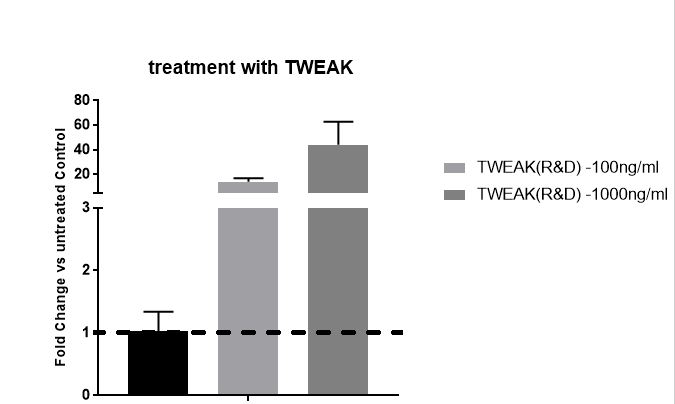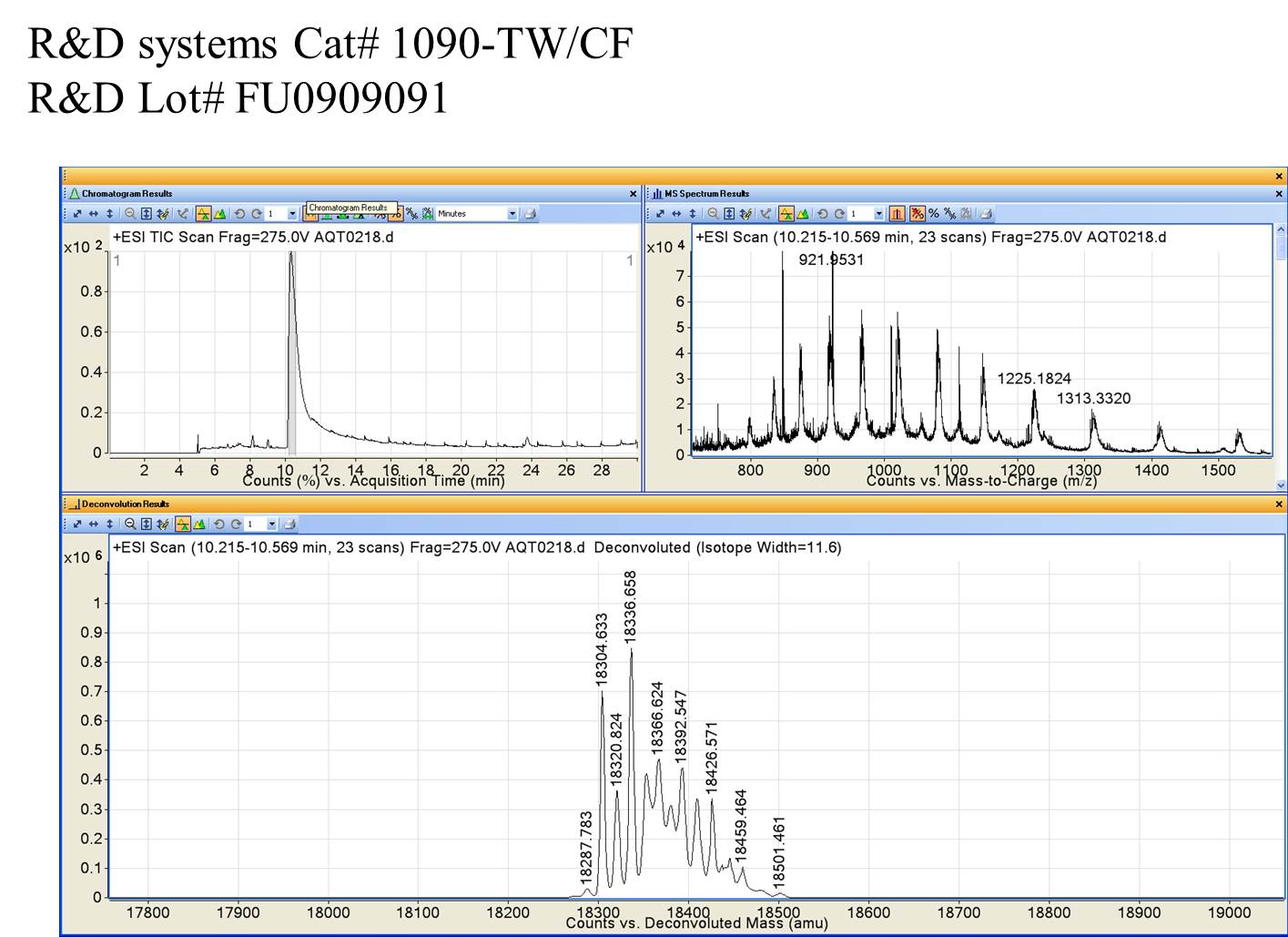Recombinant Human TWEAK/TNFSF12 Protein Summary
Product Specifications
Arg93-His249, with an N-terminal Met and 6-His tag
Analysis
Product Datasheets
Carrier Free
CF stands for Carrier Free (CF). We typically add Bovine Serum Albumin (BSA) as a carrier protein to our recombinant proteins. Adding a carrier protein enhances protein stability, increases shelf-life, and allows the recombinant protein to be stored at a more dilute concentration. The carrier free version does not contain BSA.
In general, we advise purchasing the recombinant protein with BSA for use in cell or tissue culture, or as an ELISA standard. In contrast, the carrier free protein is recommended for applications, in which the presence of BSA could interfere.
1090-TW
| Formulation | Lyophilized from a 0.2 μm filtered solution in PBS with BSA as a carrier protein. |
| Reconstitution | Reconstitute at 100 μg/mL in sterile PBS containing at least 0.1% human or bovine serum albumin. |
| Shipping | The product is shipped at ambient temperature. Upon receipt, store it immediately at the temperature recommended below. |
| Stability & Storage: | Use a manual defrost freezer and avoid repeated freeze-thaw cycles.
|
1090-TW/CF
| Formulation | Lyophilized from a 0.2 μm filtered solution in PBS. |
| Reconstitution | Reconstitute at 100 μg/mL in sterile PBS. |
| Shipping | The product is shipped at ambient temperature. Upon receipt, store it immediately at the temperature recommended below. |
| Stability & Storage: | Use a manual defrost freezer and avoid repeated freeze-thaw cycles.
|
Scientific Data
 View Larger
View Larger
Recombinant Human TWEAK/TNFSF12 (Catalog # 1090-TW) stimulates cell proliferation in HUVEC human umbilical vein endothelial cells. The ED50 is 2-8 ng/mL.
 View Larger
View Larger
1 μg/lane of Recombinant Human TWEAK/TNFSF12 was resolved with SDS-PAGE under reducing (R) conditions and visualized by silver staining, showing a single band at 19 kDa.
Reconstitution Calculator
Background: TWEAK/TNFSF12
TWEAK is a type II transmembrane protein belonging to the TNF superfamily (1). It contains a short cytoplasmic domain (aa 1‑18), the transmembrane domain
(aa 19-42) and an extracellular domain (aa 43-249). The extracellular domains of human and murine TWEAK share 89% aa sequence identity. A soluble form of TWEAK is generated from the membrane-associated molecules by proteolytic cleavage after Arg 93 suggesting that TWEAK may have long-range effects. TWEAK is expressed widely in many tissues and cells. At least two receptors that bind TWEAK have been identified (2-4). Death Receptor 3 (DR3), also known as TNFRSF12, Apo-3, LARD, WSL-1 or TRAMP, is a TNF receptor superfamily member that is expressed predominantly in tissues with high lymphocyte content (2). It has been suggested that induction of cell death by TWEAK-DR3 interaction involves the activation of NF-kappa B. In cells that lack DR3, alternate pathways of TWEAK-induced cell death mediated by receptors distinct from DR3 have been suggested (5, 6). TWEAK receptor (TWEAKR, alternatively known as FN14), is a novel TNF receptor superfamily member that also binds TWEAK (3, 4). It is a mitogen-inducible gene that is expressed in fibroblasts, hepetocellular carcinomas and endothelial cells. TWEAK-TWEAKR interaction has been shown to play a role in endothelial cell growth and migration. This effect of TWEAK is not mediated by an up-regulation of VEGF (7).
- Chicheportiche, Y. et al. (1997) J. Biol Chem. 272:32401.
- Marsters, S. et al. (1998) Current Biol. 8:525.
- Wiley, S. R. et al. (2001) Immunity, 15:837.
- Feng, S.-L.Y. et al. (2000) Am J. Path. 156:1253.
- Nakayama, M. et al. (2002) J. Immunol. 168:734.
- Schneider, P. et al. (1999) Eur. J. Immunol., 29:1785.
- Lynch, C. et al. (1998) J. Biol. Chem. 274:8455.
Citations for Recombinant Human TWEAK/TNFSF12 Protein
R&D Systems personnel manually curate a database that contains references using R&D Systems products. The data collected includes not only links to publications in PubMed, but also provides information about sample types, species, and experimental conditions.
16
Citations: Showing 1 - 10
Filter your results:
Filter by:
-
NIK/MAP3K14 in hepatocytes orchestrates NASH to hepatocellular carcinoma progression via JAK2/STAT5 inhibition
Authors: AJ Vesting, A Jais, P Klemm, L Steuernage, P Wienand, M Fog-Tonnes, H Hvid, AL Schumacher, C Kukat, H Nolte, T Georgomano, J Altmüller, M Pasparakis, A Schmidt, M Krüger, MS Supprian, A Waisman, BK Straub, N Raschzok, M Bernier, AL Birkenfeld, N Hövelmeyer, JC Brüning, FT Wunderlich
Molecular Metabolism, 2022-11-07;66(0):101626.
Species: Human
Sample Types: Whole Cells
Applications: Bioassay -
Proteolytically generated soluble Tweak Receptor Fn14 is a blood biomarker for gamma-secretase activity
Authors: G Güner, M A beta falg, K Zhao, T Dreyer, S Lahiri, Y Lo, BI Slivinschi, A Imhof, G Jocher, L Strohm, C Behrends, D Langosch, H Bronger, C Nimsky, JW Bartsch, SR Riddell, H Steiner, SF Lichtentha
Embo Molecular Medicine, 2022-09-07;0(0):e16084.
Species: Human
Sample Types: Whole Cells
Applications: Bioassay -
Evaluation of Computationally Designed Peptides against TWEAK, a Cytokine of the Tumour Necrosis Factor Ligand Family
Authors: M Badia-Vill, S Defaus, R Foj, D Andreu, B Oliva, A Sierra, N Fernandez-
International Journal of Molecular Sciences, 2021-01-21;22(3):.
Species: Human
Sample Types: Protein
Applications: Surface Plasmon Resonance -
Tumor Necrosis Factor (TNF) Receptor Expression Determines Keratinocyte Fate upon Stimulation with TNF-Like Weak Inducer of Apoptosis
Authors: X Wang, D Cheng, G Hu, L Liang, F Tan, T Xiao, S Xiao, Y Xia
Mediators Inflamm., 2019-12-05;2019(0):2945083.
Species: Human
Sample Types: Whole Cells
Applications: Bioassay -
Tumor necrosis factor-like weak inducer of apoptosis induces inflammation in Graves' orbital fibroblasts
Authors: SJ Lee, J Kim, J Ko, EJ Lee, HJ Koh, JS Yoon
PLoS ONE, 2018-12-21;13(12):e0209583.
Species: Human
Sample Types: Whole Cells
Applications: Bioassay -
An anti-TL1A antibody for the treatment of asthma and inflammatory bowel disease
Authors: AW Clarke, L Poulton, D Shim, D Mabon, D Butt, M Pollard, V Pande, J Husten, J Lyons, C Tian, AG Doyle
MAbs, 2018-03-05;0(0):1-43.
Species: Human
Sample Types: Recombinant Protein
Applications: Surface Plasmon Resonance (SPR -
NF-?B inducing kinase is a therapeutic target for systemic lupus erythematosus
Authors: HD Brightbill, E Suto, N Blaquiere, N Ramamoorth, S Sujatha-Bh, EB Gogol, GM Castanedo, BT Jackson, YC Kwon, S Haller, J Lesch, K Bents, C Everett, PB Kohli, S Linge, L Christian, K Barrett, A Jaochico, LM Berezhkovs, PW Fan, Z Modrusan, K Veliz, MJ Townsend, J DeVoss, AR Johnson, R Godemann, WP Lee, CD Austin, BS McKenzie, JA Hackney, JJ Crawford, ST Staben, MH Alaoui Ism, LC Wu, N Ghilardi
Nat Commun, 2018-01-12;9(1):179.
Species: Human
Sample Types: Whole Cells
Applications: Bioassay -
Tumor Necrosis Factor-Like Weak Inducer of Apoptosis Activates Type I Interferon Signals in Lupus Nephritis
Authors: L Xue, L Liu, J Huang, J Wen, R Yang, L Bo, M Tang, Y Zhang, Z Liu
Biomed Res Int, 2017-11-26;2017(0):4927376.
Species: Human
Sample Types: Whole Cells
Applications: Bioassay -
TWEAK mediates inflammation in experimental atopic dermatitis and psoriasis
Authors: D Sidler, P Wu, R Herro, M Claus, D Wolf, Y Kawakami, T Kawakami, L Burkly, M Croft
Nat Commun, 2017-05-22;8(0):15395.
Species: Human
Sample Types: Whole Cells
Applications: Bioassay -
TWEAK/Fn14 promotes pro-inflammatory cytokine secretion in hepatic stellate cells via NF-?B/STAT3 pathways
Authors: A Wang, F Zhang, H Xu, M Xu, Y Cao, C Wang, Y Xu, M Su, M Zhang, Y Zhuge
Mol. Immunol., 2017-04-12;87(0):67-75.
Species: Human
Sample Types: Whole Cells
Applications: Bioassay -
Down-regulation of Forkhead Box Protein A1 (FOXA1) Leads to Cancer-stem Cell-like Properties in Tamoxifen-resistant Breast Cancer Cells through Induction of Interleukin-6
Authors: N Yamaguchi, Y Nakayama, N Yamaguchi
J. Biol. Chem, 2017-03-07;0(0):.
Species: Human
Sample Types: Whole Cells
Applications: Bioassay -
Biliary tract instillation of a SMAC mimetic induces TRAIL-dependent acute sclerosing cholangitis-like injury in mice
Authors: ME Guicciardi, A Krishnan, SF Bronk, P Hirsova, TS Griffith, GJ Gores
Cell Death Dis, 2017-01-05;8(1):e2535.
Species: Human
Sample Types: Whole Cells
Applications: Bioassay -
Tumor Necrosis Factor-Like Weak Inducer of Apoptosis Promotes Hepatic Stellate Cells Migration via Canonical NF-?B/MMP9 Pathway
PLoS ONE, 2016-12-01;11(12):e0167658.
Species: Human
Sample Types: Whole Cells
Applications: Bioassay -
Regulation of fibroblast growth factor-inducible 14 (Fn14) expression levels via ligand-independent lysosomal degradation.
Authors: Gurunathan S, Winkles J, Ghosh S, Hayden M
J Biol Chem, 2014-03-20;289(19):12976-88.
Species: Human
Sample Types: Whole Cells
Applications: Bioassay -
The TWEAK receptor Fn14 is a therapeutic target in melanoma: immunotoxins targeting Fn14 receptor for malignant melanoma treatment.
Authors: Zhou H, Ekmekcioglu S, Marks J, Mohamedali K, Asrani K, Phillips K, Brown S, Cheng E, Weiss M, Hittelman W, Tran N, Yagita H, Winkles J, Rosenblum M
J Invest Dermatol, 2012-11-29;133(4):1052-62.
Species: Human
Sample Types: Whole Cells
Applications: Bioassay -
Lipocalin 2, the TNF-like receptor TWEAKR and its ligand TWEAK act downstream of NFAT1 to regulate breast cancer cell invasion.
Authors: Gaudineau B, Fougere M, Guaddachi F, Lemoine F, de la Grange P, Jauliac S
J Cell Sci, 2012-07-05;125(0):4475-86.
Species: Human
Sample Types: Whole Cells
Applications: Bioassay
FAQs
No product specific FAQs exist for this product, however you may
View all Proteins and Enzyme FAQsReviews for Recombinant Human TWEAK/TNFSF12 Protein
Average Rating: 4.3 (Based on 3 Reviews)
Have you used Recombinant Human TWEAK/TNFSF12 Protein?
Submit a review and receive an Amazon gift card.
$25/€18/£15/$25CAN/¥75 Yuan/¥2500 Yen for a review with an image
$10/€7/£6/$10 CAD/¥70 Yuan/¥1110 Yen for a review without an image
Filter by:
This was used as the ELISA calibrator with MAB1090 and AF1090 as the antibodies. It had good parallelism with human serum and plasma samples.
Reason for Rating: human cells showed induction of gene expression when treated with the protein.





